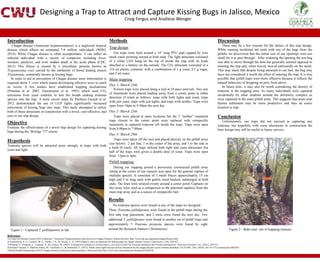
Designing a Trap to Attract and Capture Kissing Revision
- 1. Designing a Trap to Attract and Capture Kissing Bugs in Jalisco, Mexico Craig Fergus and Analiese Wenger Introduction Chagas disease (American trypanosomaisis) is a neglected tropical disease which affects an estimated 7-8 million individuals (WHO, 2014). While Chagas disease is often asymptomatic, it can inflict an infected individual with a variety of symptoms including fever, seizures, paralysis, and even sudden death in the acute phase (CDC, 2013) This illness is caused by a unicellular parasite known as Trypanosoma cruzi carried by the subfamily of blood feeding insects Triatominae, commonly known as kissing bugs. In order to aid in prevention of Chagas disease more information is required about T. cruzi which means developing effective ways to catch its vector. A few studies have established trapping mechanisms (Pimenta et al. 2007, Guerenstein et al. 1995) which used CO2 emissions from yeast volatiles to lure the breath seeking triatoma species into the trap. A more recent study by Pacheco-Tucuch et al. 2012 demonstrated the use of LED lights significantly increased enticement of kissing bugs into traps. This study attempted to utilize both of these attractants in conjunction with a novel, cost-effective, and easy to use trap design. Discussion There may be a few reasons for the failure of this trap design. While running incidental lab trials with one of the bugs from the pitfalls we discovered that the initial size of our openings were too small for it to pass through. After widening the opening the test bug was able to move through the hole but generally seemed opposed to entering the trap and, when forced, moved awkwardly on the mesh. This may mean that despite being attracted to our bait, the bug may have not considered it worth the effort of entering the trap. It is also possible that pitfall traps were more effective because it reflects the natural behaviors of dropping on prey from above. In future tests, it may also be worth considering the density of triatoma in the trapping area. As many individuals were captured incidentally by other students around the dormitory complex as were captured in the main pitfall array. This suggests that areas near human settlement may be more productive and thus an easier location to trap. Conclusion Unfortunately, our traps did not succeed in capturing any triatoma, but hopefully with some alterations in construction the base design may still be useful in future surveys. Objective Evaluate the effectiveness of a novel trap design for capturing kissing bugs during the Biology 377 course. Hypothesis Triatoma species will be attracted more strongly to traps with both yeast and light. Methods Trap design Our traps were built around a 14” long PVC pipe capped by wire mesh cones pointing inward at both ends. The light attractant consisted of a white LED hung on the top of inside the trap with its leads attached to a battery on the outside. The CO2 attractant consisted of a 118 ml plastic container with a combination of 1 g yeast, 0.5 g sugar, and 5 ml water. Main trapping Day 1- March 24th Sixteen traps were placed along a trail at 10 pace intervals. Two sets of treatments were placed leading away from a center point in either direction (4 total) as follows: traps with both lights and yeast, traps with just yeast, traps with just lights, and traps with neither. Traps were open from 10pm to 9:30am the next day Day 2- March 25th Traps were placed at same locations but the 2 “neither” treatment traps closest to the center point were replaced with conspecific treatments (a captured triatoma left inside the trap). Traps were open from 8:00pm to 7:00am Day 3- March 29th Traps were taken off the trail and placed directly on the pitfall array (see below) : 2 per line, 1 in the center of the array, and 1 to the side in a bush (8 total). All traps utilized both light and yeast attractants but half of the traps were given a double dose of yeast. Traps were open from 12pm to 4pm. Pitfall trapping During our trapping period a previously constructed pitfall array sitting at the center of our transect was open for the general capture of multiple species. It consisted of 3 metal fences approximately 15 cm high and 3 m long each with gallon sized buckets submerged at both ends. The lines were arrayed evenly around a center point. Captures on this array were used as a comparison to the potential captures from the main trap array and as a source of conspecific bait. Results No triatoma species were found in any of the traps we designed. Three Triatoma pallidipennis were found in the pitfall traps during the first tube trap placement, and 2 more were found the next day. Two additional T. pallidipennis were found in another set of pitfall traps and approximately 5 Triatoma picturata species were found by sight around the Research Station’s Dormitories.Figure 1 - Captured T. pallidipennis in lab. Figure 2 - Buho trail, site of trapping transect. References 1) Center for Disease Control (2013) Parasites - American Trypanosomiasis (also known as Chagas Disease). Retrieved from http://www.cdc.gov/parasites/chagas/disease.html 2) Guerenstein, P. G., Lorenzo, M. G., Nunez, J. A., & Lazzari, C. R. (1995) Baker's yeast, an attractant for baiting traps for chagas' disease vectors. Experientia, 51(8), 834-837. 3) Pimenta, F., Diotaiuti, L., Lutstosa, A., & Lorenzo, M. (2007). Evaluation of cultures of saccharomyces cerevisae as baits for Triatoma dimidiata and Tritoma pallidipennis. Mem Inst Oswaldo Cruz, 102(2), 229-231. 4) Pacheco-Tucuch, F., Ramirez-Sierra, M., Gourbiere, S., & Dumonteil, E. (2012). Public street lights increase house infestation by the chagas disease vector triatoma dimidiata. PLoS ONE, 7(4), e36207. doi:10.1371/journal.pone.0036207 5)World Health Organization (2013) Chagas disease (American trypanosomiasis). Retrieved from http://www.who.int/mediacentre/factsheets/fs340/en/